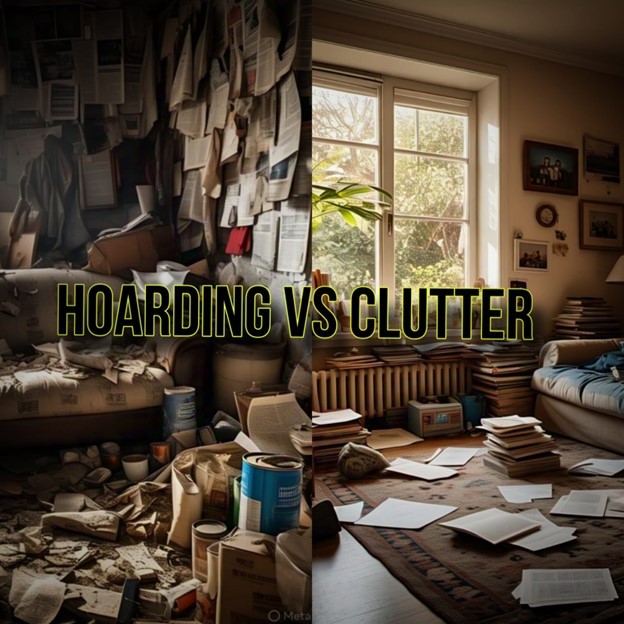
Hoarding vs Clutter: When Is It a Disorder?
Clutter and Hoarding are terms often used interchangeably, but they are not the same. While both involve an accumulation of items, hoarding is a more severe and dangerous condition. Understanding the difference between hoarding and clutter is key to recognizing when it becomes a disorder that needs attention.
What is Clutter?
Clutter is a common issue faced by many people. It often happens when there is a lack of organization or when things pile up due to a busy lifestyle. Items like old papers, clothes, and objects are usually the cause of clutter. It can be managed easily with some cleaning and tidying up.
Clutter doesn’t usually affect daily life significantly. People with cluttered spaces can still function normally, using their home or office without major problems. It’s temporary and can be dealt with by taking the time to clean or organize the area.
What is Hoarding?
Hoarding, however, is much more than just a messy house. It is a mental health disorder where an individual consistently collects items they don’t need, often to the point where it affects their quality of life. Hoarding goes beyond mere accumulation—it disrupts the ability to live comfortably or safely.
People who hoard often feel a deep emotional connection to their possessions. They might struggle to throw things away, even when those items no longer serve any purpose. Hoarding can lead to unsanitary living conditions and create dangerous situations, like blocked pathways, fire hazards, and mold. Unlike clutter, hoarding typically requires professional intervention to resolve.
Key Differences Between Clutter and Hoarding
Although both clutter and hoarding involve accumulating items, the two are different in many ways:
Emotional Attachment: How Clutter and Hoarding Differ
People with hoarding tendencies often have a strong emotional attachment to their possessions, even if they have no practical use. Clutter doesn’t come with this emotional connection and is easier to clear.
Impact on Functionality: Clutter vs Hoarding in Daily Life
While clutter may make a space feel disorganized, it doesn’t usually prevent someone from using the space for its intended purpose. Hoarding, however, can make rooms or entire areas of a home unusable, hindering normal daily activities like cooking or sleeping.
Health and Safety Risks: The Dangers of Hoarding vs Clutter
Clutter usually doesn’t pose health risks. Hoarding, on the other hand, can cause serious health and safety issues. The buildup of items can lead to falls, fires, and unsanitary conditions, including mold or pests.
Duration of Clutter and Hoarding: How Long Do They Last?
Clutter tends to be temporary and can be dealt with quickly. Hoarding, however, is a long-term problem that worsens over time if not addressed.
When Does Clutter Become Hoarding?
Clutter becomes hoarding when it starts to interfere with normal life. If the clutter makes it hard to use rooms for their intended purpose, creates safety hazards, or leads to emotional distress, it may be time to consider the possibility of hoarding. Some signs that clutter is turning into hoarding include:
- A strong emotional attachment to unnecessary items.
- Feeling overwhelmed by the clutter and unable to get rid of it.
- Difficulty maintaining a clean and safe living environment.
- Avoiding social interactions or hiding clutter from others.
How to Manage Clutter and Prevent Hoarding
Clutter can be managed by setting aside regular time to clean and organize. Assess your belongings frequently and get rid of things you no longer need. This will prevent clutter from building up and turning into a bigger issue.
However, hoarding is a mental health condition and can’t be fixed by cleaning alone. It’s important to seek professional help if hoarding is suspected. Professional organizers, therapists, and social workers can offer guidance and support to help individuals deal with hoarding behavior.
FAQs
What is DSM-5 Criteria for Hoarding Disorder?
The DSM-5 criteria for hoarding disorder include persistent difficulty discarding possessions, resulting in clutter that severely impacts functioning and causes distress.
At What Point Does Clutter Become Hoarding?
Clutter becomes hoarding when it significantly interferes with daily life, causes distress, and creates unsafe living conditions.
How Do You Tell if Someone is a Hoarder or Just Messy?
A hoarder has a strong emotional attachment to items and struggles to discard them, leading to functional impairment, while a messy person can still clear up their space without distress.
What is the Difference Between Clutter and Hoarding in Psychology?
In psychology, clutter is a temporary disorganization, while hoarding is a mental health disorder characterized by the inability to discard items, leading to safety risks and emotional distress.
Get Help with Hoarding Today
If you or someone you know is struggling with hoarding, don’t wait until it’s too late. At SCU Services, we specialize in helping individuals with hoarding and clutter-related issues. Our team is here to provide expert support, from organizing your space to offering emotional guidance, ensuring you or your loved one can live in a clean, safe environment.
Call us 24/7 at 866-614-1638 to learn how we can assist you in regaining control over your home and life. Don’t let hoarding or clutter take over—take the first step toward a healthier, more organized life today!
